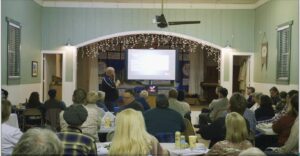Project Overview
Information Products
Commodities
Practices
- Education and Training: participatory research
- Soil Management: soil quality/health
- Sustainable Communities: leadership development
Summary:
After 3 years of soil testing, team building and information sharing in years 1-3 (2019-2021) of our 10-year-long project, the CSSHP and our 50 participating growers previously showed that lower pH, more water availability, better soil texture, more organic matter inputs, decreased tillage intensity, and more days of living cover resulted in better soil health. We also identified 4 roadblocks to increased adaptation of soil health practices, which were:
1) Only half of participating growers understood their test results and which actions were indicated.
2) 53% of growers wanted more individualized consults with soil health experts.
3) Although our entire data set identified broad soil health group trends, individual grower’s data was erratic, without clear trend lines for most growers.
4) Despite small gains in fellowship, schisms between organic and conventional growers remained, with the County’s under-review GMO ban threatening fellowship gains again.
To address these roadblocks, in 2022-2024 (years 4-6 of the project), the CSSHP committed to adding management recommendations, referrals to local soil health experts and cost-sharing referrals to our test-reporting program. We plumbed our data to identify sources of variability and added grower’s qualitative observations to supplement soil-test data. We expanded our team-building efforts to include a website, small-group problem solving exercises, and promotion of participating growers as subject matter experts. We continued to monitor our growers’ practices, attitudes and understanding to ascertain whether these actions led to an increased adoption of soil health practices, more fellowship, more information sharing, and the emergence of local soil health leaders among our participating growers.
[caption id="attachment_813475" align="alignnone" width="437"] Gunderson class on Soil Testing, 2020[/caption]
Gunderson class on Soil Testing, 2020[/caption]Project objectives:
The Citizen Science Soil Health Project, Years 4-6, addressed 3 questions: 1) Could simpler explanations of soil test results and referral to cost-share resources increase adoption of soil health practices? 2) Could increased fellowship and information sharing among growers expand local soil health successes while developing local soil health leaders? 3) Would obtaining additional soil health data reduce individual grower’s data variability and reveal individual grower’s trends? We found that the answer to all 3 questions was "Yes!"
Objectives: Participating growers would develop greater confidence and knowledge about soil health testing and results, as well as different strategies to improve their operation’s soil health. Through program participation, they would receive resources and tools through local partners in understanding and interpreting their test results, as well as resources for potential funding sources to incorporate soil health systems. Throughout this process, peers would recognize several participating growers as subject-matter experts or soil health leaders in their field.